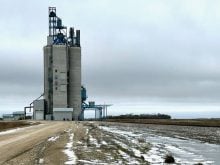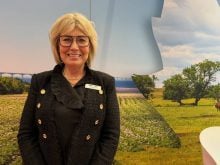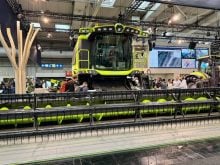Senior students at the University of Saskatchewan’s agricultural engineering program are building a quarter scale tractor that cultivates minds instead of land.
For engineers, starting a career in the field can be a rude awakening. Many engineers come out of school with a lot of knowledge but little experience in putting it to use.
Companies recruiting new engineers are realizing that the task of applying all that technical knowledge can be daunting for those who lack hands-on experience.
The U of S’s Quarter Scale Tractor Design Team is part of a project created to give agricultural engineering students a head start in getting their hands dirty.
Read Also

Farmland ownership fires up Saskatchewan politicians
Saskatchewan politicians debate the enforcement of farmland ownership laws in the province.
“They realized that a lot of the new grads they were hiring out of the universities had a lot of tech knowledge, but they didn’t know how to apply it in total machinery design,” said student Zach Martin, who has been involved with the project for two years and is the team’s captain.
Tucked away in the corner of the tractor garage at the U of S is a small, busy looking workshop.
Tires line the walls and some are split open, sacrificed in the name of experimentation. Oil stains workbenches and the floor, and specialized equipment is scattered throughout the shop.
This is the team’s nerve centre. By the time April arrives, 11 people will have spent an enormous amount of time here, designing, building and tweaking a functional, quarter scale pull tractor.
In June, the team will take the tractor to Peoria, Illinois, in the hopes of winning the American Society of Agricultural and Biological Engineers (ASABE) quarter scale tractor pulling competition.
The contest was started 11 years ago as a joint effort between machinery manufacturers and the ASABE in the hopes that it would give students more hands-on experience before graduation.
Rules for this year’s competition state the tractor must be less than eight feet long and six feet wide and weigh less than 900 pounds. Roughly 30 teams have until April to design, build and write the documentation for their creations.
The frame is designed and fabricated entirely by students, while sponsors supply mechanical components. Firestone provides free tires and Briggs and Stratton gives the team a discount on the Vanguard motors they’re required to use.
Eaton Hydraulics supplies any necessary hydraulics.
Although the main event of the competition is the tractor pull, it features other categories as well.
Last year, the U of S team’s design came in sixth overall. While it didn’t win the pulling competition, it won the manoeuvrability, serviceability and appearance categories, came in second in safety and placed fourth in ergonomics and manufacturability.
“Our problem last year was we didn’t have enough speed,” said Terry Fonstad, the team’s faculty adviser who has been involved in the contest for six years. The team’s tractor managed only about seven mph with a sled attached to it. The winning teams were in the 12 to 14 mph range.
“That’s really what they’re working on this year, is getting enough wheel speed out of the back right at the beginning of the pull.”
Fonstad expects this year’s tractor will reach 12 to 14 mph. Without the sled attached, the tractor may be able to reach 20 to 25 mph.
Although the rules state that a team can use as many motors as it wants, the U of S team is planning to use only three 18 horsepower motors.
“Perdue U came with six motors on their tractor last year, but they didn’t have much of a steering mechanism,” Fonstad said.
The weight rules make creating the tractor a balancing act between power and manoeuvrability.
“We think we can do as well with three motors and 48 hp and compete against people with five engines and 80 hp,” he said.
Fonstad said the team is experimenting with the best way to get the maximum amount of power out of its motors.
He is convinced the competition has helped graduate students and manufacturers.
“The big thing is timing, how to put the whole thing together, to work together with other people that do hydraulics and electronics.”
The project also helps students understand what is involved in undertaking a large project.
“It’s not something you do overnight or in a month. To get something of this quality takes them months and months of work.”
The engineering industry has also taken note of the competition. Many students who were involved in the project’s infancy are now working for the companies that sponsor it.
“They’re getting into a position where they’re doing the hiring,” Fonstad said.
“We’ve actually had it to the point where one of the manufacturers walked around with business cards (at the contest) and told the students, ‘If you put this program in your resume, you’re guaranteed an interview.’ “
Although the team didn’t win last year, the judges were impressed with its tractor’s functionality.
“One of the things this team was credited for, it was discussed by the judges, is the fact that the tractor (the team) designed is actually useful,” Fonstad said.
“Not only is it a pulling tractor, but you could take that tractor and sell it to an acreage owner and they could cultivate their trees with it, they could mow their grass with it.”
Dan Devisser, who has been involved with the team for the last four years although this year in more of a behind-the-scenes role, said he’s helping with whatever needs to be done and using his experience to help those with less experience.
“I just let these guys have a go at it, and they’ve been doing a good job on that so far.”
With the deadline only a few months away, the team will be working harder than ever, but Martin and Devisser wouldn’t want it any other way.
“I love it,” Martin said. “It’s a great way to get involved and apply what you’re learning in school.”
After four years, Devisser is as excited as ever to compete in Peoria.
“You’ve got to go to the competition to really get the whole experience.”














